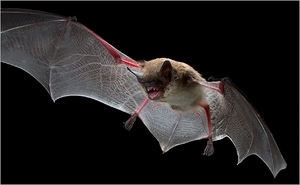
|
| ©Michael Durham/Getty Images |
| THREAT Healthy bats, like the one above, hibernate in winter. |
Al Hicks was standing outside an old mine in the Adirondacks, the largest bat hibernaculum, or winter resting place, in New York State.
But bats dying from a mystery illness have been found in the snow in daylight hours.
It was broad daylight in the middle of winter, and bats flew out of the mine about one a minute. Some had fallen to the ground where they flailed around on the snow like tiny wind-broken umbrellas, using the thumbs at the top joint of their wings to gain their balance.
All would be dead by nightfall. Mr. Hicks, a mammal specialist with the state's Environmental Conservation Department, said: "Bats don't fly in the daytime, and bats don't fly in the winter. Every bat you see out here is a 'dead bat flying,' so to speak."
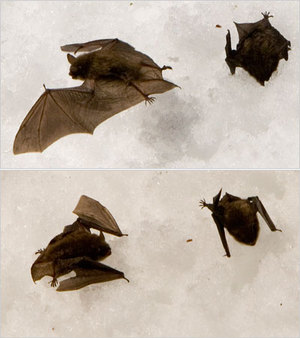
|
| ©Michael J. Okoniewski for The New York Times |
| But bats dying from a mystery illness have been found in the snow in daylight hours. |
They have plenty of company. In what is one of the worst calamities to hit bat populations in the United States, on average 90 percent of the hibernating bats in four caves and mines in New York have died since last winter.
Wildlife biologists fear a significant die-off in about 15 caves and mines in New York, as well as at sites in Massachusetts and Vermont. Whatever is killing the bats leaves them unusually thin and, in some cases, dotted with a white fungus. Bat experts fear that what they call White Nose Syndrome may spell doom for several species that keep insect pests under control.
Researchers have yet to determine whether the bats are being killed by a virus, bacteria, toxin, environmental hazard, metabolic disorder or fungus. Some have been found with pneumonia, but that and the fungus are believed to be secondary symptoms.
"This is probably one of the strangest and most puzzling problems we have had with bats," said Paul Cryan, a bat ecologist with the United States Geological Survey. "It's really startling that we've not come up with a smoking gun yet."
Merlin Tuttle, the president of Bat Conservation International, an education and research group in Austin, Tex., said: "So far as we can tell at this point, this may be the most serious threat to North American bats we've experienced in recorded history. "It definitely warrants immediate and careful attention."
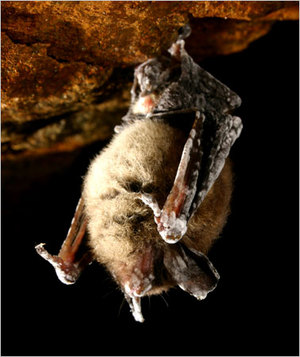
|
| ©Al Hicks |
| Bats dying from a mystery illness dotted with a white fungus. |
This month, Mr. Hicks took a team from the Environmental Conservation Department into the hibernaculum that has sheltered 200,000 bats in past years, mostly little brown bats (Myotis lucifugus) and federally endangered Indiana bats (Myotis sodalis), with the world's second largest concentration of small-footed bats (Myotis leibii).
He asked that the mine location not be published, for fear that visitors could spread the syndrome or harm the bats or themselves.
Other visitors do not need directions. The day before, Mr. Hicks saw eight hawks circling the parking lot of another mine, waiting to kill and eat the bats that flew out.
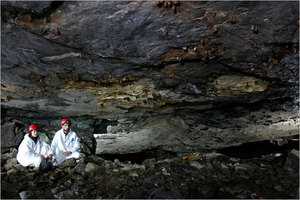
|
| ©Al Hicks |
| DIRE EFFECTS Ryan von Lindin, a biologist (with Tina Kelley of The New York Times), in a mine in the Adirondacks. |
In a dank galley of the mine, Mr. Hicks asked everyone to count how many out of 100 bats had white noses. About half the bats in one galley did. They would be dead by April, he said.
Mr. Hicks, who was the first person to begin studying the deaths, said more than 10 laboratories were trying to solve the mystery.
In January 2007, a cave explorer reported an unusual number of bats flying near the entrance of a cavern near Albany. In March and April, thousands of dead bats were found in three other mines and caves. In one case, half the dead or living bats had the fungus.
One cave had 15,584 bats in 2005, 6,735 in 2007 and an estimated 1,500 this winter. Another went from 1,329 bats in 2006 to 38 this winter. Some biologists fear that 250,000 bats could die this year.
Since September, when hibernation began, dead or dying bats have been found at 15 sites in New York. Most of them had been visited by people who had been at the original four sites last winter, leading researchers to suspect that humans could transmit the problem.
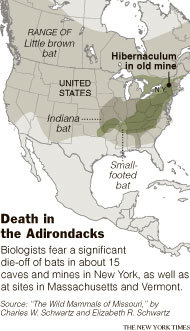
|
| ©New York Times |
Details on the problem in neighboring states are sketchier. "In the Berkshires in Massachusetts, we are getting reports of dying/dead bats in areas where we do not have known bat hibernacula, so we may have more sites than we will ever be able to identify," said Susi von Oettingen, an endangered species biologist with the United States Fish and Wildlife Service.
In Vermont, Scott Darling, a wildlife biologist with the Fish and Wildlife Department, said: "The last tally that I have is approximately 20 sites in New York, 4 in Vermont and 2 in Massachusetts. We only have estimates of the numbers of bats in the affected sites - more or less 500,000. It is impossible for us to count the dead bats, as many have flown away from the caves and died - we have over 90 reports from citizens across Vermont - as well as many are still dying."
People are not believed to be susceptible to the affliction. But New Jersey, New York and Vermont have advised everyone to stay out of all caverns that might have bats. Visitors to affected caves and mines are asked to decontaminate all clothing, boots, ropes and other gear, as well as the car trunks that transport them.
One affected mine is the winter home to a third of the Indiana bats between Virginia and Maine. These pink-nosed bats, two inches long and weighing a quarter-ounce, are particularly social and cluster together as tightly as 300 a square foot.
"It's ironic, until last year most of my time was spent trying to delist it," or take it off the endangered species list, Mr. Hicks said, after the state's Indiana bat population grew, to 52,000 from 1,500 in the 1960s.
"It's very scary and a little overwhelming from a biologist's perspective," Ms. von Oettingen said. "If we can't contain it, we're going to see extinctions of listed species, and some of species that are not even listed."
Neighbors of mines and caves in the region have notified state wildlife officials of many affected sites when they have noticed bats dead in the snow, latched onto houses or even flying in a recent snowstorm.
Biologists are concerned that if the bats are being killed by something contagious either in the caves or elsewhere, it could spread rapidly, because bats can migrate hundreds of miles in any direction to their summer homes, known as maternity roosts. At those sites, females usually give birth to one pup a year, an added challenge for dropping populations.
Nursing females can eat up to half their weight in insects a day, Mr. Hicks said.
Researchers from institutions like the Centers for Disease Control and Prevention, the United States Geological Survey's National Wildlife Health Center, Boston University, the New York State Health Department and even Disney's Animal World are addressing the problem. Some are considering trying to feed underweight wild bats to help them survive the remaining weeks before spring. Some are putting temperature sensors on bats to monitor how often they wake up, and others are making thermal images of hibernating bats.
Other researchers want to know whether recently introduced pesticides, including those released to stop West Nile virus, may be contributing to the problem, either through a toxin or by greatly reducing the bat's food source.
Dr. Thomas H. Kunz, a biology professor at Boston University, said the body composition of the bats would also be studied, partly to determine the ratio of white to brown fat. Of particular interest is the brown fat between the shoulder blades, known to assist the bats in warming up when they begin to leave deep hibernation in April.
"It appears the white nose bats do not have enough fat, either brown or white, to arouse," Dr. Kunz said. "They're dying in situ and do not have the ability to arouse from their deep torpor."
His researchers' cameras have shown that bats in the caves that do wake up when disturbed take hours longer to do so, as was the case in the Adirondack mine. He also notes that if females become too emaciated, they will not have the hormonal reactions necessary to ovulate and reproduce.
In searching for a cause of the syndrome, researchers are hampered by the lack of baseline knowledge about habits like how much bats should weigh in the fall, where they hibernate and even how many bats live in the region.
"We're going to learn an awful lot about bats in a comprehensive way that very few animal species have been looked at," said Dr. Elizabeth Buckles, an assistant professor at Cornell who coordinates bat research efforts. "That's good. But it's unfortunate it has to be under these circumstances."
The die-offs are big enough that they may have economic effects. A study of Brazilian free-tailed bats in southwestern Texas found that their presence saved cotton farmers a sixth to an eighth of the cash value of their crops by consuming insect pests.
"Logic dictates when you are potentially losing as many as a half a million bats in this region, there are going to be ramifications for insect abundance in the coming summer," Mr. Darling, the Vermont wildlife biologist, said.
As Mr. Hicks traveled deeper in the cave, the concentrations of bats hanging from the ceiling increased. They hung like fruit, generally so still that they appeared dead. In some tightly packed groups, just individual noses or elbows peeked through. A few bats had a wing around their nearest cavemates. Their white bellies mostly faced downhill. When they awoke, they made high squeaks, like someone sucking a tooth.
The mine floors were not covered with carcasses, Mr. Hicks said, because raccoons come in and feed on them. Raccoon scat dotted the rocks along the trail left by their footprints.
In the six hours in the cave taking samples, nose counts and photographs, Mr. Hicks said that for him trying for the perfect picture was a form of therapy. "It's just that I know I'm never going to see these guys again," he said. "We're the last to see this concentration of bats in our lifetime."



Reader Comments
to our Newsletter